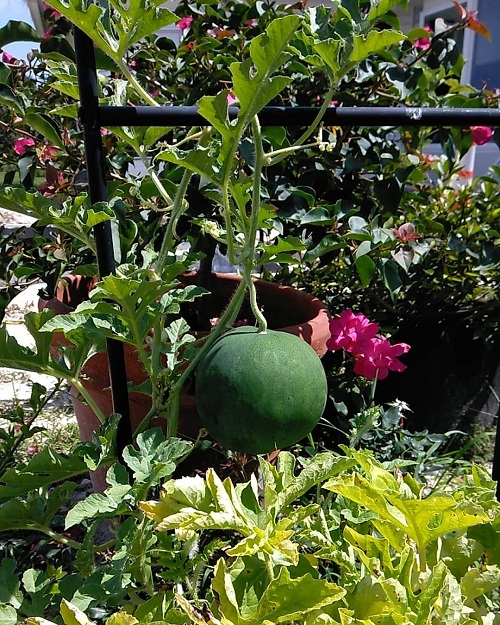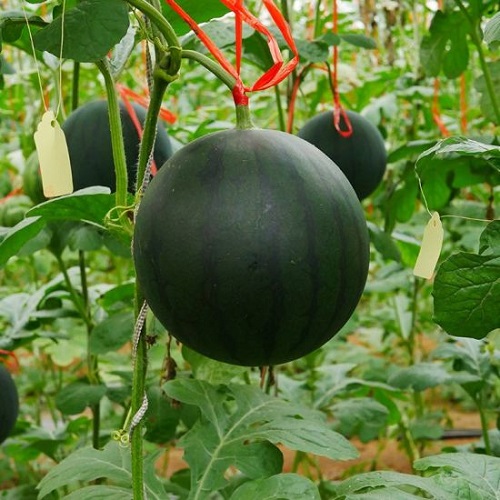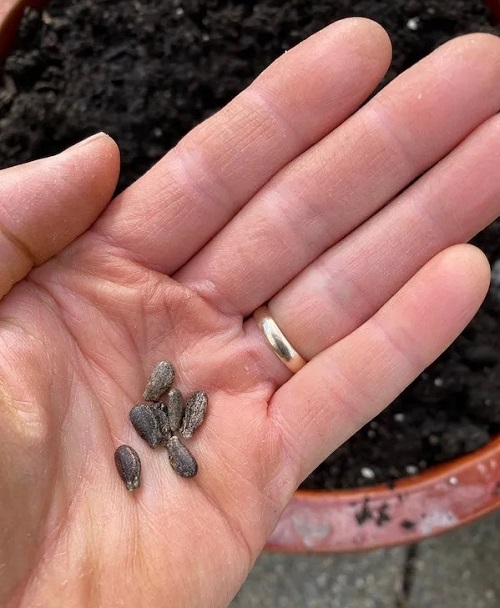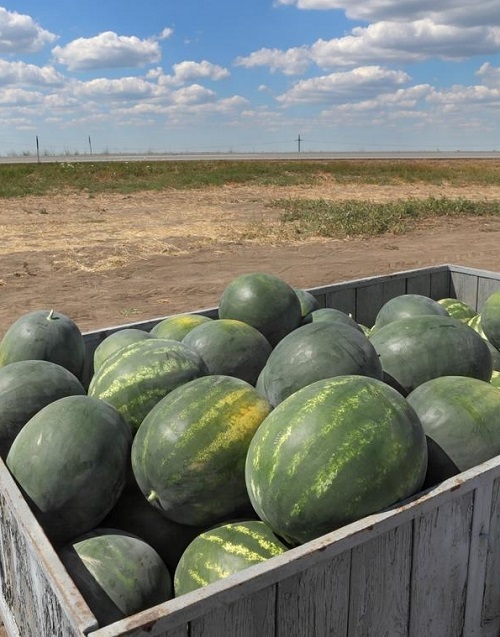Black Diamond Watermelon is not only different in looks but also offers a mouthwatering and refreshing taste! Here’s how to grow it!

If you’re interested in cultivating Black Diamond Watermelons, you’re in for a treat! This guide will provide you with straightforward instructions on how to successfully grow these tasty and visually striking fruits in your own garden!
Learn, Is Watermelon a Fruit, or a Vegetable here
Black Diamond Watermelon Information
Black Diamond Watermelons have a dark green rind, which can appear almost black. The rind is typically smooth, with a glossy finish. The fruit is known for its large size, often weighing between 20 and 50 pounds (9-23 kg), although smaller varieties are also available. When cut open, the flesh is deep red, juicy, and visually appealing.
They are generally considered to be very sweet, with a hint of natural watermelon tartness.
Black Diamond Watermelons are commonly enjoyed fresh, eaten as a refreshing snack, or included in fruit salads. Its large size makes it suitable for serving at picnics, parties, and other gatherings. It can also be used to make watermelon-based beverages, sorbets, or even grilled for a unique twist.
Botanical Name: Citrullus lanatus ‘Black Diamond’
Find How to Pick a Good Watermelon here
Propagating Black Diamond Watermelon
To ensure the successful growth of Black Diamond Watermelon, follow these steps:
- Obtain Black Diamond Watermelon seeds from a reputable source. Make sure the seeds are fresh and viable for better germination success.
- Start by soaking the seeds in warm water for about 24 hours. This helps soften the seed coat and can improve germination rates. After soaking, drain the water and allow the seeds to dry slightly.
- Fill seedling trays or pots with a good-quality seed-starting mix or peat pellets. Moisten the soil lightly before planting the seeds.
- Plant each watermelon seed about 1 inch deep into the soil. Space the seeds 2-3 inches apart in the tray, or plant one seed per pot. Cover the seeds with soil and lightly firm it down.
- Place the seed trays or pots in a warm location, ideally with a temperature between 75°F and 85°F (24°C and 29°C). Keep the soil consistently moist, but avoid overwatering, as excessive moisture can lead to damping-off or root rot.
- Black Diamond Watermelon seeds typically germinate within 7-10 days, but it can take up to 2 weeks. Keep an eye on the soil moisture and provide sufficient light for healthy seedling growth.
Find How Vinegar Improves Seed Germination (Proven by Science) here
Outdoor Planting
- Choose a sunny location in your garden with well-draining soil. Space the watermelon plants according to the recommendations for Black Diamond Watermelon, typically around 3-4 feet apart in rows with about 6-8 feet between rows.
- Black Diamond Watermelon plants are sprawling vines that benefit from trellises or supports to keep the fruit off the ground. Consider using stakes or trellises to support the vines as they grow.
Growing Black Diamond Watermelon in Pots
You can grow these watermelons in pots as long as you use the right size. Go for at least 24-28 inch containers.
Since space may be limited in a pot, consider providing support for the watermelon vine to climb. Use a trellis or stakes to train the vines vertically. This can help save space and prevent the fruit from sitting directly on the ground, reducing the risk of rot and pests.
Requirements for Growing Black Diamond Watermelons
Location
Adequate sunlight is crucial for Black Diamond Watermelon. As with all melon varieties, these plants require a minimum of 6 to 8 hours of daily sunshine to ensure robust growth and development.
Soil
Black Diamond Watermelons prefer loamy soil that is loose, well-draining, and fertile. Loamy soil contains a balanced mixture of sand, silt, and clay, providing good drainage while retaining enough moisture for the plants.
Incorporate organic matter into the soil to improve its fertility and moisture-holding capacity. Compost, well-rotted manure, or aged leaf mold are excellent choices. Add a generous amount of organic matter and mix it into the soil before planting.
Learn some Great Tips to Rejuvenate Your Old Soil here
They prefer slightly acidic to neutral soil with a pH range of 6.0 to 7.0. Test the soil pH and make adjustments as necessary to achieve the desired range. Adding organic matter can help buffer the soil’s pH and improve its overall balance.
Water
Watermelons require consistent moisture, especially during the growing season. Water Black Diamond Watermelons deeply and thoroughly, ensuring the root zone is adequately moistened. As a general rule, watermelons need about 1-2 inches of water per week. However, this can vary depending on climate, soil conditions, and stage of growth.
Monitor the moisture level of the soil by inserting your finger or a moisture meter into the soil near the base of the plant. If the top 1-2 inches of soil feels dry, it’s time to water. Avoid allowing the soil to become excessively dry or waterlogged, as both conditions can negatively impact the plants.
Here are the best ways to water plants
It’s generally best to water Black Diamond Watermelons in the morning. This allows the foliage to dry during the day, reducing the risk of fungal diseases.
Temperature
Black Diamond Watermelons thrive in temperatures between 70°F and 90°F (21°C to 32°C) during their growth and fruit development stages.
Warmer temperatures help promote vigorous growth, flowering, and fruit set. Higher temperatures can enhance fruit sweetness and quality.
Read about the Best Watermelon Companion Plants and the Bad Ones here
Black Diamond Watermelon Care

Fertilizer
Before planting Black Diamond Watermelons, incorporate a balanced fertilizer (10-10-10 0r 20-20-20) into the soil. Generally, you can use around 2-3 pounds (0.9-1.4 kg) of fertilizer per 100 square feet (9.3 square meters) of garden bed.
As watermelons continue to grow and develop, feed them with a balanced liquid fertilizer, diluted to 1/2 of its strength, once in 2-3 weeks.
Here are the Best Fruit Peels You Can Use as Fertilizers
If you prefer organic fertilizers, you can use well-rotted compost, aged manure, or organic fertilizers formulated specifically for vegetables. Follow the package instructions.
Pests & Diseases
When growing Black Diamond Watermelons, it is crucial to remain watchful for common pests and fungal diseases that can affect the plants. The primary pests to be cautious of include melon aphids, cucumber beetles, squash bugs, and squash vine borers.
Likewise, fungal diseases like powdery mildew, Alternaria leaf spot, stem blight, and downy mildew can pose a threat to the plants. To avoid these issues, refrain from overwatering and wetting the foliage.
Click here to learn the Amazing Natural Pesticide Recipe that can Kill any Pest
To minimize the risk of infestation and disease, it is advisable to avoid planting watermelons in an area where other plants from the cucurbit or squash family were grown in the previous year. This helps prevent the carryover of pests and diseases that may affect the Black Diamond Watermelons.
Learn How to Grow Yellow Watermelons here
Harvesting Black Diamond Watermelons
- Observe the Rind Color: Pay attention to the color of the Black Diamond Watermelons‘s rind. Most watermelons are ready for harvest when the rind turns dull or matte rather than shiny. For example, a watermelon with a green rind may turn yellowish or cream-colored when ripe.
- Test the Sound: Gently tap or thump the watermelon with your knuckles. A ripe watermelon will produce a deep, hollow sound, indicating that it is full of water and has developed properly.
- Size and Weight: While size can vary depending on the watermelon variety, a ripe Black Diamond Watermelon should feel heavy for its size.
- Taste Test: If you are unsure about the ripeness, cut a small slice from Black Diamond Watermelons and taste it. A ripe watermelon will have a sweet and juicy flavor, indicating that it is ready to be harvested.





